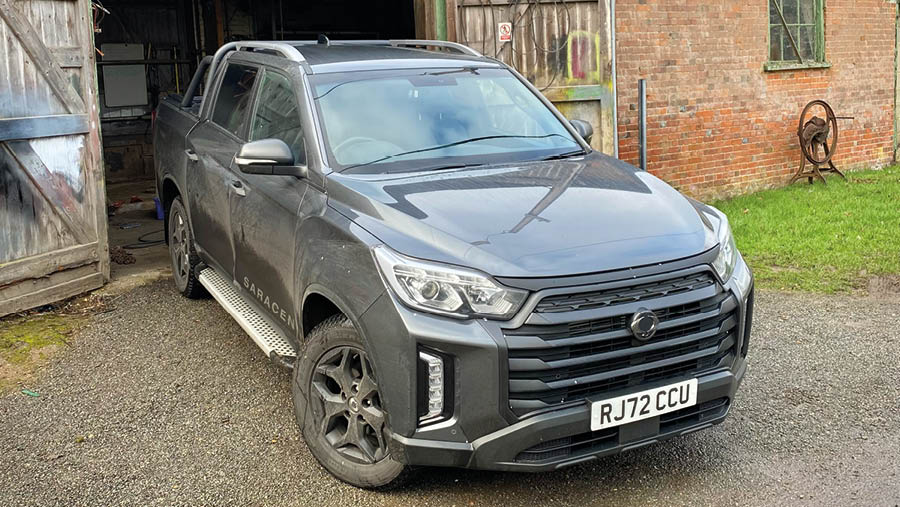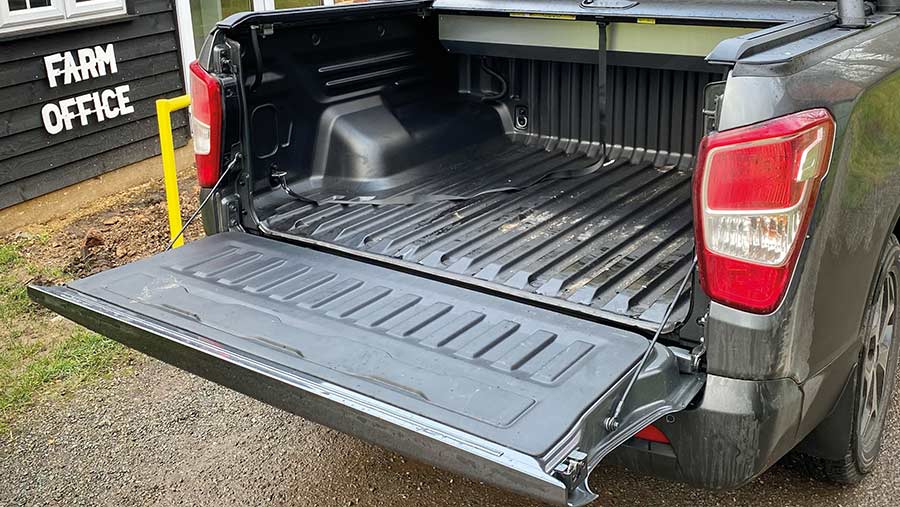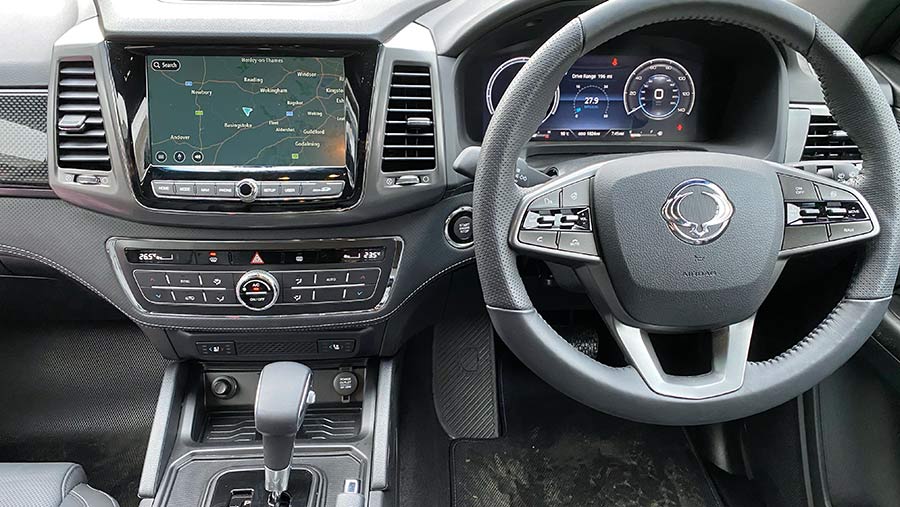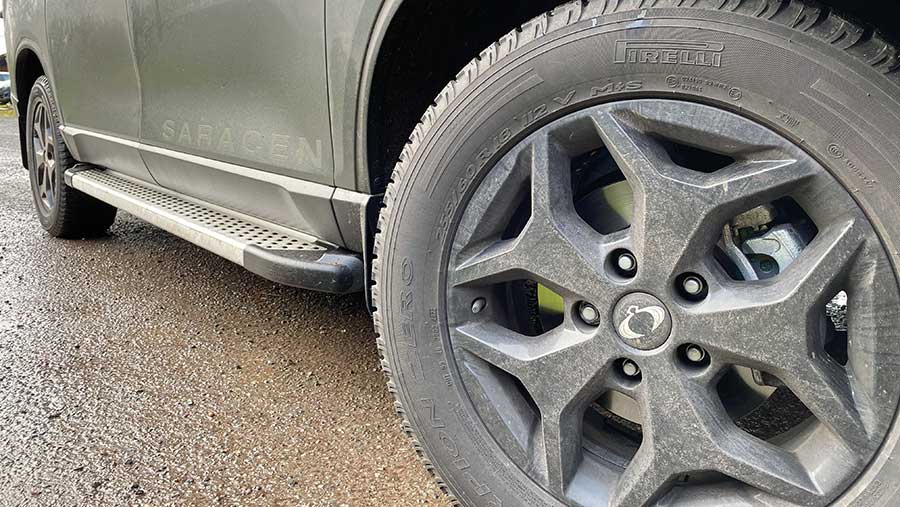On test: Time for Ssangyong’s well-priced Musso pickup?
 © MAG/Oliver Mark
© MAG/Oliver Mark After years doggedly plugging away at the UK pickup market, Ssangyong has suddenly found itself catapulted to a heady fourth spot in the sales rankings.
Facetious it may be – a lull in demand has led to mass desertion, leaving just a quartet of makers in the game – but there is merit in the staying power it has demonstrated while more powerful foes have succumbed to market forces.
See also: Pickup buyer’s guide 2022-23
And there’s actually plenty to like about the Musso. Its capacity to tow and carry matches – and in some cases beats – the competition, its interior is pleasingly car-like, and the price half sensible.
Its biggest weakness, previously, was the performance of the rear suspension.
UK-bound models were retrofitted with stiffer coils that, without any load in the bed, had the dislikeable knack of wobbling passengers à la jelly on a plate – even on innocuous looking roadways.
But what of the latest iteration, seen here in top spec Saracen guise?
According to Ssangyong, it received not just cosmetic tweakments but a Madonna-esque “aggressive facelift” in 2021.
The Musso seems a bit young for that sort of caper – it was only launched three years earlier…
New look
Fortunately, the surgery isn’t as extreme as intimated in the blurb.
New stuff includes a ladder-like grille and some finicky folds and creases in the tinwork, including two front wing coves that, from less favourable angles, look rather like dents.
As it is based on the Rexton SUV, there are also some quirks to its design.
For example, the rear doors are clumsily stepped at the base of the window, forming a protruding corner with a nasty habit of catching unsuspecting passengers plumb on the funny bone as they slam them shut.
It also means more space is dedicated to interior than exterior, leaving a short, deep load area.
This can still swallow a Euro pallet but lumping in bags and buckets without opening the tailgate relies on executing an Olympic standard clean-and-jerk to avoid causing harm to the bodywork.

Loadbed © MAG/Oliver Mark
The upshot is liberal space in and around the front seats.
The driver gets a well-positioned rest for the left foot, comfortable, softly upholstered perches for the elbows and an A-pillar grab handle, leaving this writer with few ill-effects from a 1,500-mile slog.
Another handle in the roof lining would be the icing on the cake.
The front chairs, finished in luxurious Nappa leather on the Saracen, offer cooling/heating functions and electric adjustment in most directions, including lumbar support.
Even those in the back row get single-stage seat warmers and, by pickup standards, bountiful legroom. In-cab storage space is also practical and abundant.
But the mass of tech is both blessing and curse.
The items mentioned above are generally useful.
Cruise control is worth having and the Car Play-compatible touchscreen, standard on all but the base EX and measuring 9.2in on the ritziest models, is of decent resolution – albeit troubled by a glitch on our test model.
However, other bits fall into the solution-in-need-of-a-problem camp.
Several subtly different variations of the dashboard display are available by thumbing one of umpteen buttons on the steering wheel, which seems somewhat pointless.

© MAG/Oliver Mark
And, as in previous iterations, it has a habit of sounding alerts and displeasure too often – binging and bonging for speed limit breaches (not me, guv), the presence of speed cameras, handbrake position, key location, and various other unfathomable reasons.
Then there’s the overzealous central locking system, which makes it near impossible to reach the fuel filler from the driver’s side without having to dig out the key again. Keyless entry would be a boon.
It’s also missing potentially useful gadgets, many of which can be found on the Isuzu D-Max.
Examples include autonomous emergency braking, traffic sign recognition and, on top spec models, adaptive cruise control.
Driving

© MAG/Oliver Mark
The 2.2-litre e-XDi220 block is surprisingly refined, with effective baffling keeping engine noise to a library-like murmur and plenty of rubber around the doors largely eliminating the drone of tyres on tarmac.
It has respectable poke too, with its 202hp and 420Nm of torque handsomely trumping the D-Max (164hp/320Nm).
However, that most certainly doesn’t translate into speed, with the sprint to 62mph taking 12secs.
No surprise, then, that the Musso doesn’t lend itself to overly spirited driving, despite having the same chassis and engine as the Rexton.
Gear shifts through the six-speed auto are largely completed with stealth but get too keen, or too indecisive, on the throttle and lumps quickly appear.
As for consumption, we found it yielded 30mpg on a motorway run, but nearer 25mpg on the back roads.
Body roll is kept fairly well in check and, though the coil springs on the back still have a high-frequency jitter without weight in the load bed, it’s far less pronounced than before and generally comfortable.
The exception is lightly pockmarked roads, which tend to make the ride more fidgety.
The switch to four-wheel drive is done via a small dial neighbouring the handbrake.
This is a part-time 4×4 system with a locked central differential, meaning it’s predominantly rear-wheel drive with power to the front engaged and disengaged according to speed discrepancies between the two.
As a result, it’s not designed for use on the road.
There’s also a low range and electronic traction control (although no manually engaged lock for the rear diff), plus hill start assist and hill descent systems.
Its sub-par 215mm of ground clearance isn’t ideal, and certainly not helped by a chin that dangles unnecessarily low at the front.
Notably, the Musso is the only pickup rated to carry a 1t payload and tow 3.5t simultaneously (6,750kg gross train weight).
However, that only applies to models with the automatic transmission – manuals are limited to a 3.2t towing capacity.
Which one to buy?
With one cab configuration, one engine and two transmissions (six-speed auto or manual), picking a Musso really comes down to fit and finish.
The austere EX props up the range, yet still brings little luxuries such as air conditioning, auto headlights and rain-sensing wipers, plus 17in alloys.
Mid-range Rebels add an 8in touchscreen, reversing camera, heated and ventilated leather-look seats, side steps and roof rails.
Then comes the Saracen, where fake leather is swapped for the real stuff, the rear seats are heated and there’s dual-zone climate control.
Also standard are a 9.2in screen, cruise control, front and rear parking sensors, tinted rear windows, blind spot detection and lane change assist.
Earlier this month, Ssangyong launched the Saracen+, which has a 305mm longer load bed and slightly higher payload, but is otherwise the same as the standard Saracen.
On-the-road prices (ex-vat) are as follows:
- EX (manual) – £25,140
- Rebel (auto) – £29,140
- Saracen (auto) – £32,540
- Saracen+ (auto) – £33,790
Farmers Weekly verdict
Ssangyong remains something of an automotive outlier, but it is ramping up its UK presence and now has 80 dealers spread across the country.
Whether it can proliferate quite as effectively as Isuzu, particularly in the countryside, remains to be seen, but it has the raw ingredients to succeed.
With a smooth engine, respectable power and adequately slick transmission, there’s little to dislike in the drivetrain department, and there are plenty of creature comforts too.
At just over £25k, the base-spec EX appears the most suitable farm vehicle, with its DAB radio an acceptable downgrade from the fancy screen and some of the less important techy bits thinned out.
However, its 3.2t towing capacity might be a problem.
That said, even the Saracen isn’t a bank-breaker – and it’s backed up by a five-year, 100,000-mile warranty. Food for thought, indeed…
Likes and gripes
✔ Decent carrying and towing capacity on auto models
✔ Smooth engine
✔ Smart, spacious interior
✘ Short, high-sided load bed
✘ Towing limited to 3.2t on manual version
✘ Limited ground clearance, particularly at the front
Ssangyong Musso Saracen spec
- Engine: 2.2-litre, four-cylinder diesel
- Max power: 202hp@3,800rpm
- Max torque: 441Nm@1,600-2,600rpm
- Transmission: Aisin six-speed auto
- Max speed: 113mph
- 0-62mph: 11.9sec
- Combined consumption: 31.5mpg
- Wheelbase: 3,100mm
- Ground clearance: 215mm
- Turning circle: 11.8m
- Kerb weight: 2,155kg
- Max payload: 1,095kg
- Towing capacity: 3,500kg
- On-the-road price: £32,540
